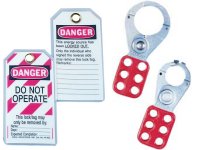NFPA 70E
Standard
for Electrical Safety in the Workplace,
2009 Ed.
|
Description:
|
Author:
NFPA |
OSHA bases
its electrical safety mandates on NFPA 70E®: Standard for
Electrical Safety in the Workplace®. Prevent accidents and
comply!
Avoid accidents and OSHA fines with
the 2009 NFPA 70E®: Standard for Electrical Safety in the
Workplace®!
Shock, electrocution, arc flash, and arc blast
are responsible for hundreds of worker deaths and thousands of
injuries per year in the U.S. alone. Save lives with NFPA 70E:
Electrical Safety in the Workplace, the Standard developed for
OSHA that details the "hows" behind compliance with OSHA 1910
Subpart S and OSHA 1926 Subpart K.
The 2009 edition is revised to
recognize new hazards and increase safety on the job.
Personal Protective Equipment (PPE) protects
personnel and can significantly reduce the risk of injury in an arc
flash. To help engineers calculate incident energy--the first step
in determining the correct type of PPE for a given task—a new Annex
D in the 2009 NFPA 70E consolidates all equations, adds new
tables, and offers more options to detailed calculations. For
example, a new utility table derived from the NEC helps utility and
industrial plant workers calculate PPE based on voltage and fault
current data.
Improved work practices reduce risks:
- A new requirement for Fire Rated
clothing for H/R Category 1 precludes the use of cotton
clothing. This change reduces the risks for second-degree thermal
burns.
- An expanded Table in Article 130
covers added tasks such as thermographic imaging, and new
equipment including arc-resistant switchgear.
- Added Article 350 provides
first-time requirements for the protection of electrical personnel
in R&D labs.
- A new exception verifies
that 240 V and less power systems fed by a single transformer less
than 125 kvs no longer require an arc flash hazard analysis.
- Expanded requirements for
multi-employer relationships address potential areas of oversight,
and improves contractor communication about electrical hazards.
- New recordkeeping requirements
for training and safety program audits answer OSHA's need for
records and ensure data is available when you need it.
Other changes
expand your know-how:
- Easy-to-see shading
identifies new or revised Standard text.
- Annex F clarifies the Hazard/Risk
evaluation procedure and provides sample worksheets.
- A flow chart in Annex J
helps users determine the need for an Energized Electrical Work
Permit.
- Annex M helps workers and
supervisors evaluate layering of PPE.
- Annex N explains safe work
practices near overhead and underground lines.
Engineers, designers, risk managers,
maintainers, safety directors, contractors, and owners need the
2009 NFPA 70E to improve worker safety and avoid
citations, rising insurance fees, and increased workman's comp
costs
Contents:
NFPA 70E Standard for
Electrical Safety in the Workplace 2009 Edition
ARTICLE 90 Introduction
Chapter 1 Safety-Related Work Practices
ARTICLE 100 Definitions
ARTICLE 110 General Requirements for Electrical Safety-Related
Work Practices
ARTICLE 120 Establishing an Electrically Safe Work Condition
ARTICLE 130 Work Involving Electrical Hazards
Chapter 2 Safety-Related Maintenance Requirements
ARTICLE 200 Introduction
ARTICLE 205 General Maintenance Requirements
ARTICLE 210 Substations, Switchgear Assemblies, Switchboards,
Panelboards, Motor Control Centers, and Disconnect Switches
ARTICLE 215 Premises Wiring
ARTICLE 220 Controller Equipment
ARTICLE 225 Fuses and Circuit Breakers
ARTICLE 230 Rotating Equipment
ARTICLE 235 Hazardous (Classified) Locations
ARTICLE 240 Batteries and Battery Rooms
ARTICLE 245 Portable Electric Tools and Equipment
ARTICLE 250 Personal Safety and Protective Equipment
Chapter 3 Safety Requirements for Special Equipment
ARTICLE 300 Introduction
ARTICLE 310 Safety-Related Work Practices for Electrolytic Cells
ARTICLE 320 Safety Requirements Related to Batteries and Battery
Rooms
ARTICLE 330 Safety-Related Work Practices for Use of Lasers
ARTICLE 340 Safety-Related Work Practices: Power Electronic
Equipment
ARTICLE 350 Safety-Related Work
Requirements:
Research and Development Laboratories
Chapter 4 Installation Safety Requirements
ARTICLE 400 General Requirements for Electrical Installations
ARTICLE 410 Wiring Design and Protection
ARTICLE 420 Wiring Methods, Components, and Equipment for
General Use
ARTICLE 430 Specific Purpose Equipment and Installations
ARTICLE 440 Hazardous (Classified) Locations, Class I, II, and
III, Divisions 1 and 2 and Class I, Zones 0, 1, and 2
ARTICLE 450 Special Systems
Annex A Referenced Publications
Annex B Informational References
Annex C Limits of Approach
Annex D Incident Energy and Flash Protection Boundary
Calculation Methods
Annex E Electrical Safety Program
Annex F Hazard/Risk Evaluation Procedure
Annex G Sample Lockout/Tagout Procedure
Annex H Simplified, Two-Category, Flame-Resistant (FR) Clothing
System
Annex I Job Briefing and Planning Checklist
Annex J Energized Electrical Work Permit
Annex K General Categories of Electrical Hazards
Annex L Typical Application of Safeguards in the Cell Line Working
Zone
Annex M Layering of Protective Clothing and
Total System Arc RatingAnnex N
Example Industrial Procedures and Policies for Working Near
Overhead Electrical Lines and Equipment
Annex O Safety-Related Design
Requirements
IndexProposal Forms
Related:

Lockout/Tagout Supplies
Lockout/Tagout
Kits
* * * * * * *
2020 NEC & Related Reference & Study
Guides

1418065595
/
9781418065591
|